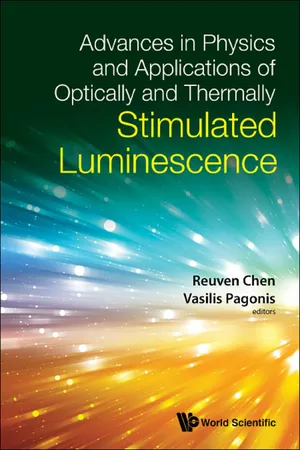
Advances in Physics and Applications of Optically and ThermallyStimulated Luminescence
- 528 pages
- English
- ePUB (mobile friendly)
- Available on iOS & Android
Advances in Physics and Applications of Optically and ThermallyStimulated Luminescence
About This Book
In this volume, international leading experts in the study of thermally and optically luminescence give an up-to-date, comprehensive coverage of the theoretical and experimental aspects of these subjects, as well as their applications.
The theory of thermoluminescence (TL) and optically stimulated luminescence (OSL) are discussed in detail including mainly solid state models of localized and delocalized transitions. These models cover the effects occurring during the excitation by irradiation and the read-out by heating or by exposure to light. The methods described consist of analytical mathematical considerations as well as numerical simulations.
The main application of these effects, namely radiation dosimetry, includes personal and environmental dosimetry, as well as retrospective dosimetry and the dosimetry of cosmic radiation and space missions. Also discussed in detail are archaeological and geological dating, the use of luminescence dosimetry in medical physics as well as general applications in geosciences, other model subjects such as time-resolved luminescence and thermally assisted OSL, and the sister-subject of thermoluminescence in photosynthetic materials.
Contents:
- Recent Advances in the Theory of Thermoluminescence and Optically Stimulated Luminescence; Delocalized Transitions (Reuven Chen)
- Recent Advances in the Theory of Quantum Tunneling for Luminescence Phenomena (Vasilis Pagonis)
- Modeling the Effects of Ionization Density in Thermoluminescence Mechanisms and Dosimetry (Yigal S Horowitz, Leonid Oster and Ilan Eliyahu)
- Thermally Assisted Optically Stimulated Luminescence (TA – OSL) (George S Polymeris and George Kitis)
- Luminescence and Defects in Quartz (Marco Martini and Mauro Fasoli)
- Recent Experiments and Theory of OSL (Alicja Chruścińska)
- Time-resolved Luminescence: Progress in Development of Theory and Analytical Methods (Makaiko L Chithambo)
- Thermoluminescent Dosimetry of Cosmic Radiation in Space (Paweł Bilski)
- Luminescence Measurements for Retrospective Dosimetry (Stephen W S McKeever and Sergey Sholom)
- TL/OSL Dating (Sheng-Hua Li and Bo Li)
- Fundamentals of Luminescence Photo- and Thermochronometry (Benny Guralnik and Reza Sohbati)
- Medical Applications of Luminescent Materials (Larry A DeWerd, Cliff Hammer and Stephen Kry)
Readership: Graduate student and professional for research.Thermoluminescence (TL);Optically Stimulated Luminescence (OSL;Dosimetry;Retrospective Dosimetry;Archaeological and Geological Dating0 Key Features:
- Interdisciplinary coverage of the subjects of TL, OSL and other luminescence properties, written by international experts of the different subfields
- Up-to-date description of scientific results, analysis, methods and applications of TL and OSL
- Combination of different viewpoints and approaches on TL and OSL study underone roof
Frequently asked questions
Information
CHAPTER 1
Recent Advances in the Theory of Thermoluminescence and Optically Stimulated Luminescence; Delocalized Transitions
Tel Aviv University, Tel Aviv 69978, Israel
[email protected]
1.1.Introduction





Table of contents
- Cover
- Halftitle
- Title
- Copyright
- Contents
- Preface
- Chapter 1. Recent Advances in the Theory of Thermoluminescence and Optically Stimulated Luminescence; Delocalized Transitions
- Chapter 2. Recent Advances in the Theory of Quantum Tunneling for Luminescence Phenomena
- Chapter 3. Modeling the Effects of Ionization Density in Thermoluminescence Mechanisms and Dosimetry
- Chapter 4. Thermally Assisted Optically Stimulated Luminescence (TA – OSL)
- Chapter 5. Luminescence and Defects in Quartz
- Chapter 6. Recent Experiments and Theory of OSL
- Chapter 7. Time-resolved Luminescence: Progress in Development of Theory and Analytical Methods
- Chapter 8. Thermoluminescent Dosimetry of Cosmic Radiation in Space
- Chapter 9. Luminescence Measurements for Retrospective Dosimetry
- Chapter 10. TL/OSL Dating
- Chapter 11. Fundamentals of Luminescence Photo- and Thermochronometry
- Chapter 12. Medical Applications of Luminescent Materials
- Author Index
- Subject Index